MOVEABLE TYPE by 0xDEAFBEEF
Moveable Type: Forward
The idea for this project came to me during the open edition "meta" of 2023, at the same time as Wordle had gone viral. I had the idea to do a timed open edition of letters, which afterwords could be combined through a burn mechanism to crystallize into words and sentences. However the gas transaction costs on Ethereum Mainnet proved too expensive, so I shelved it.In summer 2024, I was approached about doing a project on Shape L2. With its low gas transaction costs and a stated mission of foregrounding the potential for programmable NFTs as a "web" of interacting elements (rather than simply certificates of ownership) I thought it could be a a good fit.
Primarily, Moveable Type is experimental, open-ended, participatory word game. I had been reading about the history of writing and print, and wanted to extend the project to try to make some connections to this history, in relation to culture and technology of programmable blockchains. In the end, I was concerned it wouldn't communicate on its own everything I wanted, so I caved and wrote this long winded essay to weave together some context, and make connections to some art, games and writings that have been influential to me. My hope is that its entertaining and informative.
As a newb scholar of media history, it was surprising to me to realize how writing and typography had indeed drastically (yet unconsciously) affected own understanding of concepts as seemingly fundamental as time. If there's any takeaway, it's to share my surprise with other newb media scholars. As we experiment with blockchains, let us remain critically aware of how a communication technology can powerfully influence our commonly held beliefs and understanding of the world. Shut up, just tell me how it works
Dead Words, Reanimation, Blockchain
Spoken words are events, and require breath to be actualized. Unlike written words, they are not objects, but events that take place in the context of an immediate life world between a living speaker, living audience in a living environment. In many indigenous cultures, stories are powerfully tied to specific geographical locations. Among many examples, Western Apache 'agodzaahi tales (literally "that which has happened") always begin with statement of where the events take place. Without that association, the story would not "make sense", literally in our original manner of knowing anything -- through sensual interaction with a living environment (Abrams, 160)In oral culture, names are not just abstract, interchangeable labels for things. In fact, labels could not exist at all as words could not be seen. Names have a much stronger association, often conveying power over things. Adam naming the animals is more just than a quaint parable. (Ong)
Writing began to loosen that association. If words could exist on their own, in visual form, they became more like objects, sometimes magical ones: "Scraps of writing are used as magical amulets, but they can also be valued simply because of the wonderful permanence they confer on words." (Ong)
Orality maintained prominence long after the advent of writing, which served principally as a means to record oral forms (Homer's epic poetry, Plato's dialectics). Writing was meant to be read aloud; it's purpose was as a visual mnemonic for speech, which carried greater importance in all domains. Politics, scholarship, law all took place orally, perhaps for good reason.
Writing began the "separation of the word from the living present". (Ong), Ong writes about the startling paradox of the close association of writing with death. (Ong, 81) Numerous quotations alude to this, including 2 Corinthians 3:6 'The letter kills but the spirit gives life'. Plato's Phaedrus dialogues suggest that writing is inhuman, thing-like and memory destroying. Henry Vaughan's asserts that 'every book is thy epitaph'. Concerning the widespread practice of pressing dead flowers between the pages of books, "the dead flower, once alive, is the psychic equivalent of the verbal text" (Ong 81). Words lay dormant, waiting to be reanimated by living breath as events in the present.
Print typography further strengthened the conception of writing as independent, visual objects, engendering a sense of closure, fixity, self-containment - markedly different from oral forms that are open and dynamic. Printed words became ".. set off from other works, a unit in itself. Print culture gave birth to the romantic notions of 'originality' and 'creativity', which set apart an individual work from other works even more, seeing its origins and meaning as independent of outside influence, at least ideally" (Ong)
Compared to the decay of recopied written manuscripts, the improved reliability of print typography seduced authors with immortality: "The printing press, then only a century old, had been mistaken for an engine of immortality, and men hastened to commit to it deeds and passions for the benefit of future ages." ( E.M. Forster via Mcluhan, 203)
Similarities abound in the culture of blockchain and NFTs. Proponents see it as a means of storing artworks for eternity. Artists and collectors imagine their art, or artworks they own, mythologized in a future when all will agree on the primacy of their favorite blockchain as an immortal, self-contained record of culturally significant works.
Early proponents of cryptocurrency were extropians some of whom freeze their bodies or brains for a later reanimation. In blockchain culture, art with 'on-chain' storage is seen a gurantee of its preservation. Like dead flowers between pages, a blockchain may guarantee storage, but does not guarantee re-animation, which depends on a future living interpreter to give it life. Not only through actuation(whether through spoken breath, a browser emulator, or the promises of a technological singularity), but through reconnection with the context of the living present, in absence of which, a preserved artifact can never "make sense". Written words, on-chain SVG and P5JS scripts can lay crystalized and dormant, like the embalmed Egyption pharaohs, or the cryogenically frozen brains of Extropians, awaiting spiritual reanimation in a future time. Hold your breath!
Lists, Platonic forms, Loot
Oral culture has no lists, in the way that we currently understand them. Lists are a visual form, as are charts and figures. It would be very odd to speak an abstract, neutral list. Rather, the oral equivalent of lists were situated in some type of conjunctive narrative that describes itemized knowledge in a "human action context." (Ong, 42) (TODO: examples from Iliad, Bible) Such a narrative may serve as a mnemonic, but is also simply because an oral culture "conceptualizes and verbalizes more or less all their knowledge with close reference to the human lifeworld." (Ong 42)Spoken language was organically tied to the speaker and to the worldly environment. Writing began the "separation of the word from the living present." (Ong). Words came to have an independent existence, no longer dependent on the physical world or speech. Plato was among the first generation to be formally educated in alphabetical reading. Havelock argues that Plato's influential theory of ideal forms were revealed to him by alphabetic writing itself. "Like letters, Platonic ideas were immobile, isolated, and devoid of warmth and secondary qualities; they seem to transcend the world at hand." (Davis 19) As Abram observes, "The letters, and the written words that they present, are not subject to the flux of growth and decay, to the perturbations and cyclical changes common to other visible things; they seem to hoever, as it were, in another, strangely timeless dimension". (Abram, ??)
"Democritus, a contemporary of Plato, was the first to argue that the holistic tapestry of the cosmos was actually made up of discrete atoms. Not coincidentally, Democritus compared this atomic structure to the way that written words were formed from the bits of the alphabet" (Davis, 21) Proponents of programmable blockchain ledgers such as Ethereum see smart contracts as fundamental atomic computational units, capable of being composed into higher level structures, to represent anything that consensus of their users deems fit, within the precisely defined constraints of their code, independent of what advocates see as the messiness, subjectivity and arbitrariness of current societal conventions. That motivation appears to mirror Gnostic urge to transcend the material world. As Erik Davis argues, the influence of Neoplatonism/Gnosticism spans an arc that began with writing, and accelerated through typographic literacy through to modern technoscientific thought.
The NFT collection Loot has a purity in both aesthetics and technical embodiment. The itemized textual aesthetic recalls an iconic example of print culture - the list. Whether intentionally, it also recalls conceptual artist Joseph Kosuth. Loot is implemented as a self contained Ethereum smart contract, written independently by its author Dom Hoffman and released without any marketing platform, website or user interface. Only an announcement, were given away for free, and that people were free to use it "in any way you want." As Ong says of the closure of printed works, ".. set off from other works, a unit in itself [...] as independent of outside influence, at least ideally". (Ong 133)
Loot's incredible (but brief) popularity during the NFT mania of 2021 was in part fuelled by a narrative that echoed Platonic idealism, relating it on par to the change from orality to alphabetic literacy as a fundamental, abstract, ever lasting atomic layer on which entire transcendent worlds could potentially be built. Although its market dynamics at the peak of NFT mania seem an unlikely occurence, it's much more believable considering the overlap among NFT enthusiasts with the common ideologies of tech entrepreneur, and fantasy gaming culture, themes explored in Simon Denny's Dungeon exhibition. Kevin Buist places Loot in the context of ectogames.
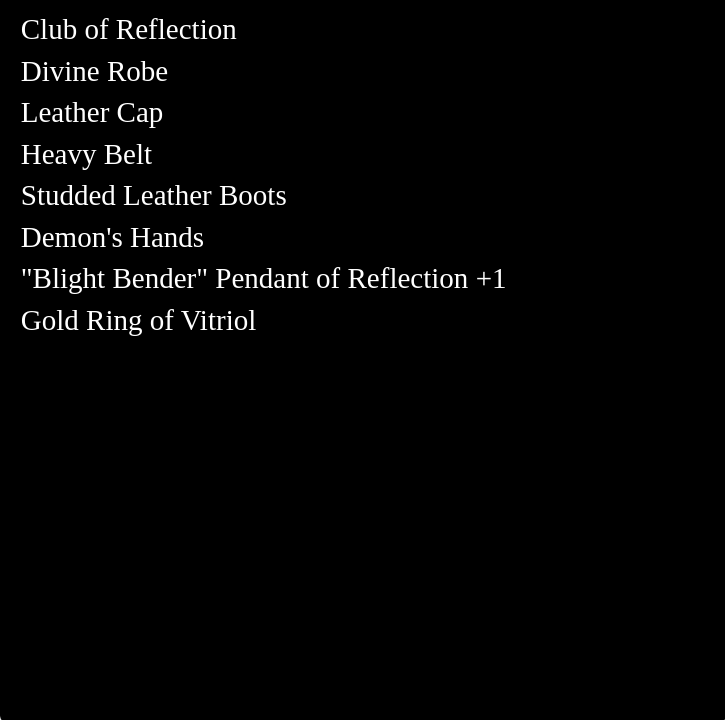
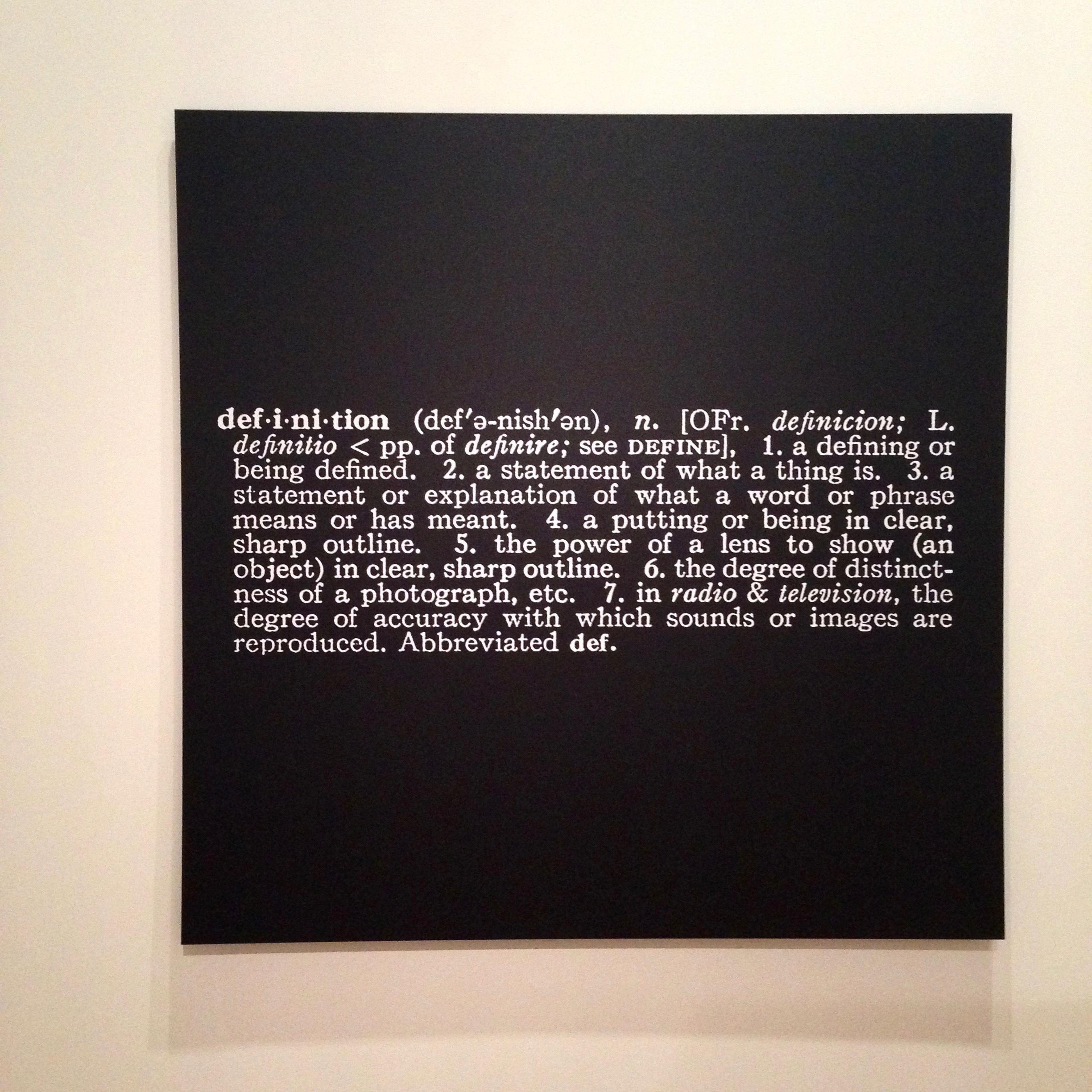
-------
ASCII, Roguelikes, Transmutation
Alphabetical writing is a discretization of sound. While all writing moves from the sound world to visual space, print locks them in position, "situating words in space more relentlessly than writing ever did", seen in such developments as "lists, especially alphabetic indexes, in the use of words (instead of iconographic signs) for labels... and in the use of abstract typographic space to interact geometrically with printed words in a line of development that runs from Ramism to concrete poetry." (Ong, 123) The culture of print permeates mechanical looms, industrial machines and computation devices. Computer terminals display grids of monospaced text. Just as concrete poetry arose from type, character terminal screens were hijacked to display ASCII art.The influential game Rogue (1980) (after which the "Roguelike" genre is named) used spatial affordances of character terminals to show an interactive, 2D overhead dungeon map, that was procedurally generated randomly, offering a unique topology on each replay. Dennis Ritchie, creator of the C programming language, later joked that Rogue was perhaps "the biggest waste of CPU cycles in history." Rogue was heavily influenced by table top fantasy game Dungeons and Dragons(Dnd), used pencil, paper and dice as an equivalent, but slower, computational mechanism for structuring interactions. (Note that the first iteration of DnD had a rule sheet that was only one page long, leaning heavily on the human imagination.)
What Roguelike games lacked in graphical sophistication, they made up for in gameplay. Rather than a prescriptively narrow, guided expected behaviour (like a 2d scroller), Roguelikes favour flexible and rich interactions between all entities (objects, actors, items, terrain). As a kind of discrete cybernetic system, complex and unpredictable interactions between atomic entities lead to emergent phenomenon and gameplay, not specifically designed by the author.
ASCII Roguelike aesthetics are evident in the simulation game Dwarf Fortress that makes iconic use of coloured Unicode characters to represent a complex dynamic world. Dwarf Fortress was in turn a key influence for the extremely popular game Minecraft. Minecraft abandons ASCII symbols, but retains the foregrounding of discretized space (blocks), crafting mechanics, and rich interactions. Over more than a decade, the community of Minecraft users continue to developed elaborate mechanisms of interacting crafted discrete elements, unanticipated by their creators.
Alchemical traditions considered relationships between symbols inscribed in geometric arrangements. Minecraft crafting mechanism transmutation of raw resources from randomly generated environments into refined materials or tools to procure even rarer materials until we arrive at gold and diamonds. Claudia Hart notes the alchemical association, a distillation and concentration of value vis-a-vis deflationary token economics and Proof of Work algorithms.
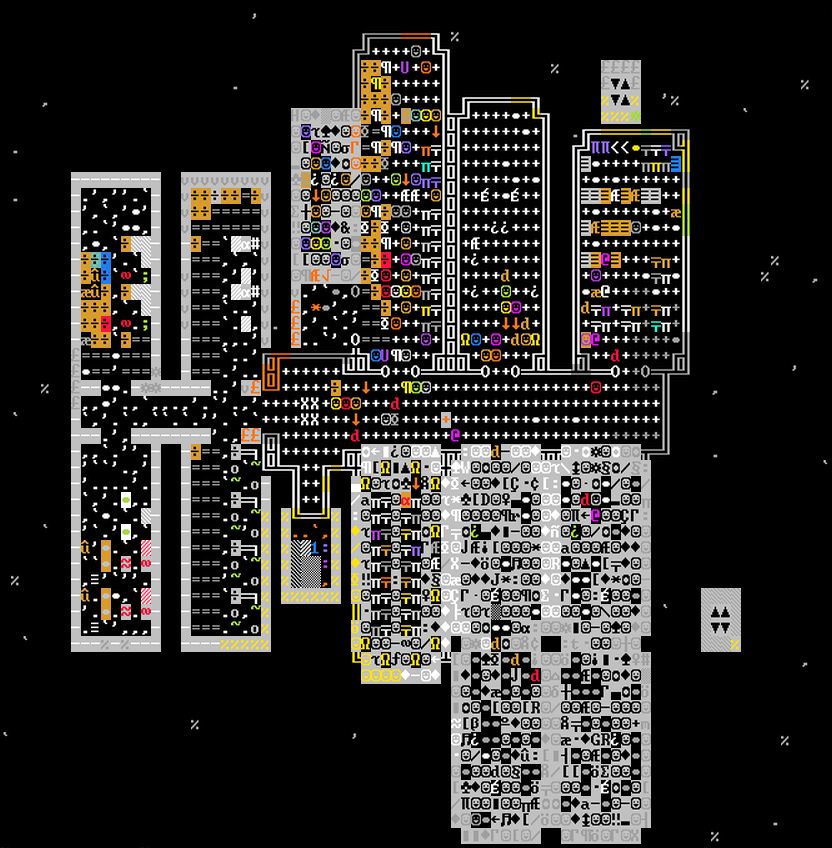

Code is Law
under construction. In secondary oral cultures, authenticity of written documents was not nearly as important as testimony, oral statements. Symbol physical artifacts sometimes accompanied the written documents as authentication. Regarding mistrust of writing, Plato points out that a book/document cannot be questioned and made to answer the way a speaker could. vis-a-vis interpretation of the coded rules of smart contracts. Some see exploiting a smart contract not as theft, but as arbitrage, a rigid adherence to "code is law". Compare this to customary laws preserved through oral sayings and wisdom were constantly being adapted and reinterpreted in present context, so were always up to date. (Ong)Cut up Technique, Divination
There are many examples of language and writing used as a dynamic and recombinative device. In oral culture, the customary laws preserved through oral sayings and wisdom were constantly being adapted to the present, so were always up to date. (Ong) Ancient Hebrew text is written without vowels, demanding a wilful engagement that is "interactive and interpretive". The Torah is not a "body of dogmatic truths but a living enigma that must be questioned, grappled with, and interpreted afresh in every generation." (Abram) Greek Isopsephy and Kabbalistic technique of gematria were used as an exegetical tool to uncover hidden meaning and relationships in sacred texts. Interpreted in another way by Rhea Myers, "Gematria in Hebrew uses a SIGINT attack on God's fully homomorphic encryption of the book of nature to extract meaning." (Rhea Myers, "Hash Gematria") Avant-garde artist Tristan Tzsara cut up letters and sprinkled them to generate new texts. William Burroughs saw cut-up technique as a method of divination "When you cut into the present, the future leaks out." In her work, poet and artist Ana Maria Caballero contemplates reading and writing as a collective, generative process.In connection with these themes, the artwork Firsts draws inspiration from Loot and indirectly from dadaist sensibilities via artist's previous familiarity with Frank Zappa. As a relatively simple cut up technique, a program pieces together text fragments according to some straightforward rules that follow a template, ala Mad Libs. The generative texts satirize the market driven obsession with primacy in the NFT space circa 2021, producing many absurd statements of NFT 'firsts'. In the months and years after it's release, some of the most absurdly specific statements came true (i.e. "The first Punk-derivative animal themed 10k avatar NFT to land on the moon.")
Because of the decisive provenance of these predictions (blockchain's temporal ordering), some remain in awe of seemingly magical predictive power. The true magic is the influence they are under: the spell of print culture. Utterances set down in print (or blockchain) are given a certain reverence as independent objects, of authorial pronouncement. Under this spell, one forgets that in oral cultures, even sacred knowledge is constantly under creative re-interpretation in the present. The powers of divination stem from the act of choosing from among a vast corpus of possibilities to drop into a present situation that seems to perfectly fit.
Jack Burnham, after studying the alchemical symbols in Marcel Duchamp's artworks, later in his career turned to Kabbalist interpretation of artworks. He viewed artworks as information processing devices, as revelatory language that only had meaning in the time and place of it's utterance. Artworks of the past were like old weather reports; (cite interview) only of historical interest.
Roy Ascott's "La Plissure du texte" from 1983 - translated "The Interweaving of the text", a pioneering telematic (networked) from 1983. Drawing inspiration from literary theorist Roland Barthes "La Plaisir du texte", this work collaborative reading/writing process from participants around the world, a process he named "distributed authorship".
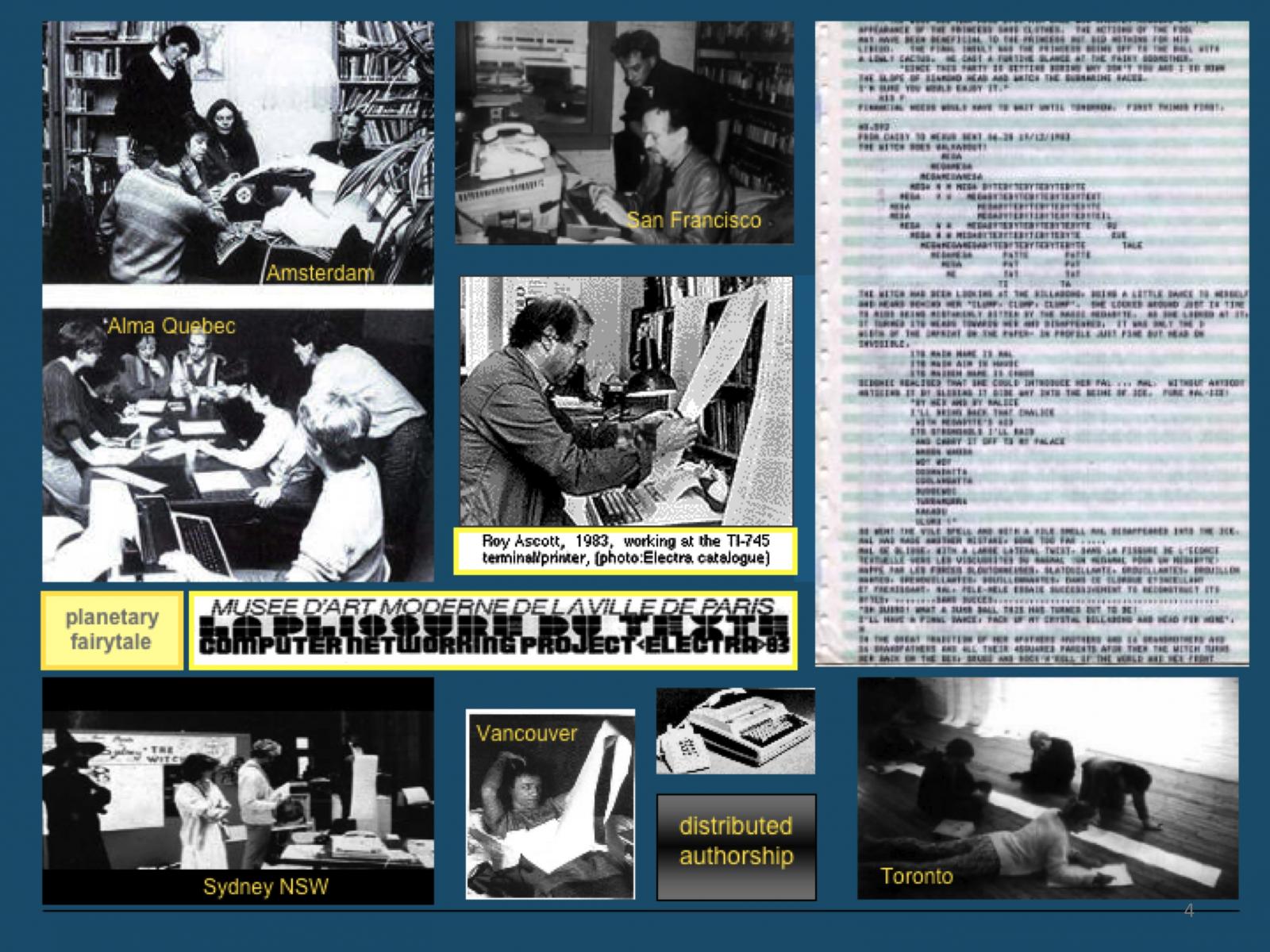
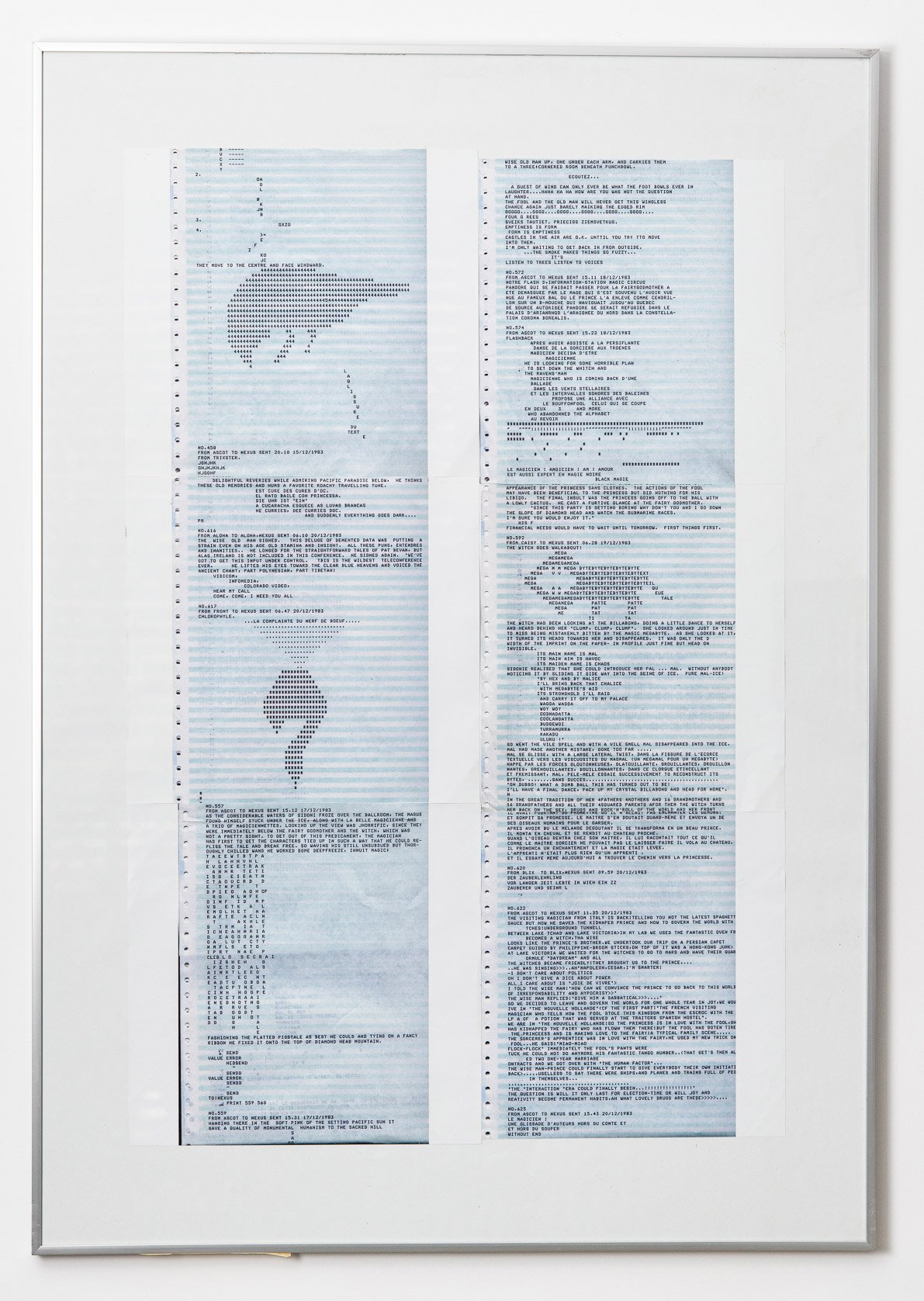
The Value of Words
"We have all heard it said that one picture is worth a thousand words. Yet, if this statement is true, why does it have to be a saying?" (Ong) The first writing was for record keeping, Phonecians were traders; the alphabet was a tool of commerce. Words were worn as amulets, with belief in their power and value. Knowing or giving name to something is to have power over it. The biblical story of Adam naming the animals and the hierarchical taxonomies of plant/animal "kingdoms" reflect the Western anthropocentric view. Collectors of rare generative art NFT editions name their artworks to confer status: The Goose, The Tulip, The Bear Glyph. Memecoins are the names of animals: dogs, frogs, cats.Ownership of ideas became possible with typographic fixity, which "made possible more explicit recognition of individual innovation and encouraged the staking of claims to inventions, discoveries, and creations." (Eisenstein, 93) The printing press created innumerable business opportunities, from "new forms of personal celebrity" for authors, to mass produced plenary indulgences.
Print allowed for standardization and record keeping. Vanity license plates demand a premium only because they are enforceably unique within a standardized body of records. Domain names derive their value from uniqueness, and for another practical reason. Before search engines, a URL had to be typed in the address bar: memorized magic words to psychically transport you to the owner's virtual domain. Short, memorable names were the most magical and the most valuable, significant enough to label the entire era: "dot com"
Deflation, Rumpelstiltskin, Proof of Work
A verifiably fixed supply is a valued property of a cryptocurrency, reassuring owners that they cannot be diluted by centralized printing of additional currency. Limited edition NFT artworks also tout their fixed supply, or sometimes even their deflationary mechanics. Framergence and Checks allow owners to "burn" multiple tokens in exchange for a single new token of greater rarity, comparable to an alchemical distillation - a concentration of value.Reflecting on inscribing her artwork as Bitcoin ordinals, Claudia Hart likens the process to an alchemical ritual, and the "impossible belief that inscribing a tiny file into one millionth of one millionth of a Bitcoin embeds it into infinity." Erik Davis writes "The Egyptians believed that a name captured the essence of a thing, but they also held that such supernatural power lived in the inscriptions themselves."
To give or know the true name of a being is to have power over it. Rumpelstiltskin could spin straw into gold, and played a game allowing 3 guesses of his secret name. To enact its Proof of Work algorithm, the Bitcoin network plays the same game, but guesses quintillion times before naming the hash of the next block, furiously spinning useless cycles into valuable cryptographic certainty.
Chronology and Authorship
Poet and artist Sasha Stiles has extensively explored intersections of text and technology, including generative AI and blockchain. She writes that "poetry is the original blockchain". In an oral culture, knowledge was communally recalled and spoken through mnemonics such as poetic rhythms, rhymes and alliteration. Oral poetry and blockchain are both decentralized mechanisms of storage and consensus.On the other hand, orality and even written manuscript culture(before typography), differ sharply from blockchains with respect to chronology and authorship.
Our modern conception of time is borne out of the affordances of print. Many oral cultures think of time as cyclical; in accordance with our lived experience. Linear time is a product of print: there is no experiential reason to conceive of the current date as situated in spacial grid to the right of the previous. Without a standardized, consensus reference point, numerical dates and times are quite arbitrary. "It appears unlikely that most persons in medieval or even Renaissance western Europe would ordinarily have been aware of the number of the calendar year.. Why should they be? [...] The abstract calendar number would relate to nothing in real life." (Ong 98) Modern conception of time has been shaped by the proliferation of calendars, charts, dated records afforded by the technology of print.
In oral culture, "the terms plagiarism and copyright did not exist for the minstrel. It was only after printing that they began to hold significance for the author." (Eisenstein 94) Even in manuscript culture, not much importance was assigned to provenance or authorship. Overlapping roles of scribe/writer made it impractical to know the origins of texts. Writing was seen as a craft. One was a "bookmaker" the same way one was a cobbler or blacksmith, and it did not necessarily imply authorship. Manuscripts were referred to by the first line of their content. If a writer's name was included at all, it was recorded at the end, like movie credits. Print culture reversed this procedure: publishers put themselves first, with a title page advertising the print firm's name, emblem and address and "extended their new promotional techniques to the authors and artists whose work they published, thus contributing to new forms of personal celebrity" (Eisenstein, 33)
While minimized in oral culture, authorship and chronology(temporal order) are values of print culture, and pillars of blockchain culture. Much has been written about time and blockchain, notably Rhea Myers' essay "Blockchain Temporalities", and Charlotte Kent and Alex Estorick's survey of artists exploring blockchain temporality. Blockchains are clocks - the Bitcoin whitepaper refers to the network as a "timechain". Blockchain irrefutably records when (a temporal order measured in blocks) and who ( in the sense of who controls the cryptographic private key at the time of transaction).
The emphasis on primacy in NFT culture is evident in the language of artist's "genesis mints", the constant pronouncements and arguments over firsts, the inclusion of dates directly in titles of artworks, i.e. alignDRAW (2015), the endless themes of grails, pioneers and ancient artifacts. It's advantageous for NFT collectors and artists to frame blockchain as a historical blank slate, to choose a new temporal reference point. It's notable that following many years of such rhetoric for NFTs minted on Ethereum, the advent of Bitcoin Ordinal inscriptions in 2022 repeated it again, with a new temporal reference point and claim to primacy.
Blockchain commonalities with the historical precedent of print, and the possibility of the degree of its future importance being comparable to that of print, is used as a narrative to give aura and justify the value of any minted artifact, independent of its context in other temporalities and histories. "Exploitation of the mass medium of print was more common among pseudoscientists and quacks than among professional scientists, who often withheld their work from the press. When important treatises did appear in print, they rarely achieved the status of bestsellers." (Eisenstein, 209)
"Early charters conveying land in England were originally not even dated.. the most profound reason was probably that 'dating required the scribe to express an opinion about his place in time', which demanded the he choose a point of reference. What point? Was he to located this document by reference to the creation of the world? To the Crucifixion? To the birth of Christ? Popes dated documents this way, from Christ's birth, but was it presumptuous to date a secular document as popes dated theirs?" (Ong, 97)
Due to the ubiquitousness of print it's difficult to be aware of the ways that it's changed our consciousness, our assumptions and conceptions. Chronology, provenance, intellectual property were products of print. Exactly how and to what degree blockchain technology may affect these remains to be seen, but we should remain critically aware of a communication technology's power to do so. The history of writing and print offers some precedents.
Bibliography
- Orality and Literacy: The Technologizing of the Word - Walter J. Ong
- Proof of Work: Blockchain Provocations 2011-2021 - Rhea Myers
- The Spell of the Sensuous - David Abram
- TechGnosis - Erik Davis
- The Printing Revolution in Early Modern Europe, Second Edition - Elizabeth Eisenstein
- The Gutenberg Galaxy - Marshall McLuhan
- Beyond Modern Sculpture - Jack Burnham
Artists Mentioned
- Anna Maria Caballero
- Rhea Myers
- Sasha Stiles
- Jack Butcher - Checks
- Arihz - Framergence
- Dom Hoffman - Loot
- Joseph Kosuth
- Tristan Tzara
- Frank Zappa
- Tarn and Zack Adams - Dwarf Fortress
- William Burroughs